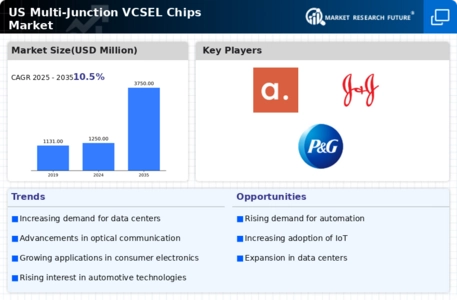Market Growth Projections
The Global US Multi-Junction VCSEL Chips Market Industry is poised for substantial growth, with projections indicating a market size of 1250 USD Million in 2024 and an anticipated increase to 3750 USD Million by 2035. This growth trajectory suggests a compound annual growth rate of 10.5% from 2025 to 2035, reflecting the increasing demand for VCSEL technology across various sectors. The market's expansion is driven by advancements in laser technology, rising adoption in consumer electronics, and the growing focus on energy efficiency. As industries continue to innovate and integrate VCSEL solutions, the market is likely to experience robust development.
Advancements in Laser Technology
Technological advancements in laser technology significantly influence the Global US Multi-Junction VCSEL Chips Market Industry. Innovations in manufacturing processes and materials have led to enhanced performance characteristics of VCSEL chips, such as improved efficiency and reduced production costs. These advancements enable the chips to cater to a wider range of applications, including consumer electronics and industrial automation. As companies invest in research and development, the market is expected to see a compound annual growth rate of 10.5% from 2025 to 2035. This growth trajectory underscores the potential of multi-junction VCSEL chips to revolutionize various sectors.
Expansion of Automotive Applications
The Global US Multi-Junction VCSEL Chips Market Industry is significantly impacted by the expansion of automotive applications. With the rise of autonomous vehicles and advanced driver-assistance systems, VCSEL chips are increasingly utilized for LiDAR and optical sensing technologies. These applications require precise and reliable performance, which VCSEL technology can provide. As automotive manufacturers prioritize safety and efficiency, the integration of VCSEL chips is likely to become more prevalent. This trend not only enhances vehicle capabilities but also contributes to the overall growth of the market, as the automotive sector continues to evolve.
Increased Focus on Energy Efficiency
Energy efficiency remains a critical driver for the Global US Multi-Junction VCSEL Chips Market Industry. As industries strive to reduce their carbon footprint, the demand for energy-efficient solutions has intensified. VCSEL chips, known for their low power consumption and high output, align with these sustainability goals. This focus on energy efficiency is particularly relevant in sectors such as telecommunications and data centers, where operational costs are closely tied to energy usage. The growing emphasis on green technologies is likely to propel the adoption of VCSEL chips, further solidifying their position in the market.
Rising Demand for Data Communication
The Global US Multi-Junction VCSEL Chips Market Industry experiences a surge in demand driven by the increasing need for high-speed data communication. As industries transition to more advanced networking technologies, VCSEL chips are favored for their efficiency and performance. In 2024, the market is projected to reach 1250 USD Million, reflecting a growing reliance on optical communication systems. This trend is further supported by the expansion of data centers and cloud services, which require robust and reliable data transmission solutions. The adoption of VCSEL technology in these sectors indicates a strong trajectory for growth in the coming years.
Growing Adoption in Consumer Electronics
The Global US Multi-Junction VCSEL Chips Market Industry is witnessing increased adoption of VCSEL technology in consumer electronics. Devices such as smartphones, tablets, and wearables are increasingly incorporating VCSEL chips for applications like facial recognition and augmented reality. This trend is driven by the need for enhanced user experiences and security features. As the consumer electronics market expands, the demand for high-performance VCSEL chips is expected to rise, contributing to the market's projected growth. By 2035, the market is anticipated to reach 3750 USD Million, highlighting the pivotal role of VCSEL technology in shaping the future of consumer devices.













Leave a Comment